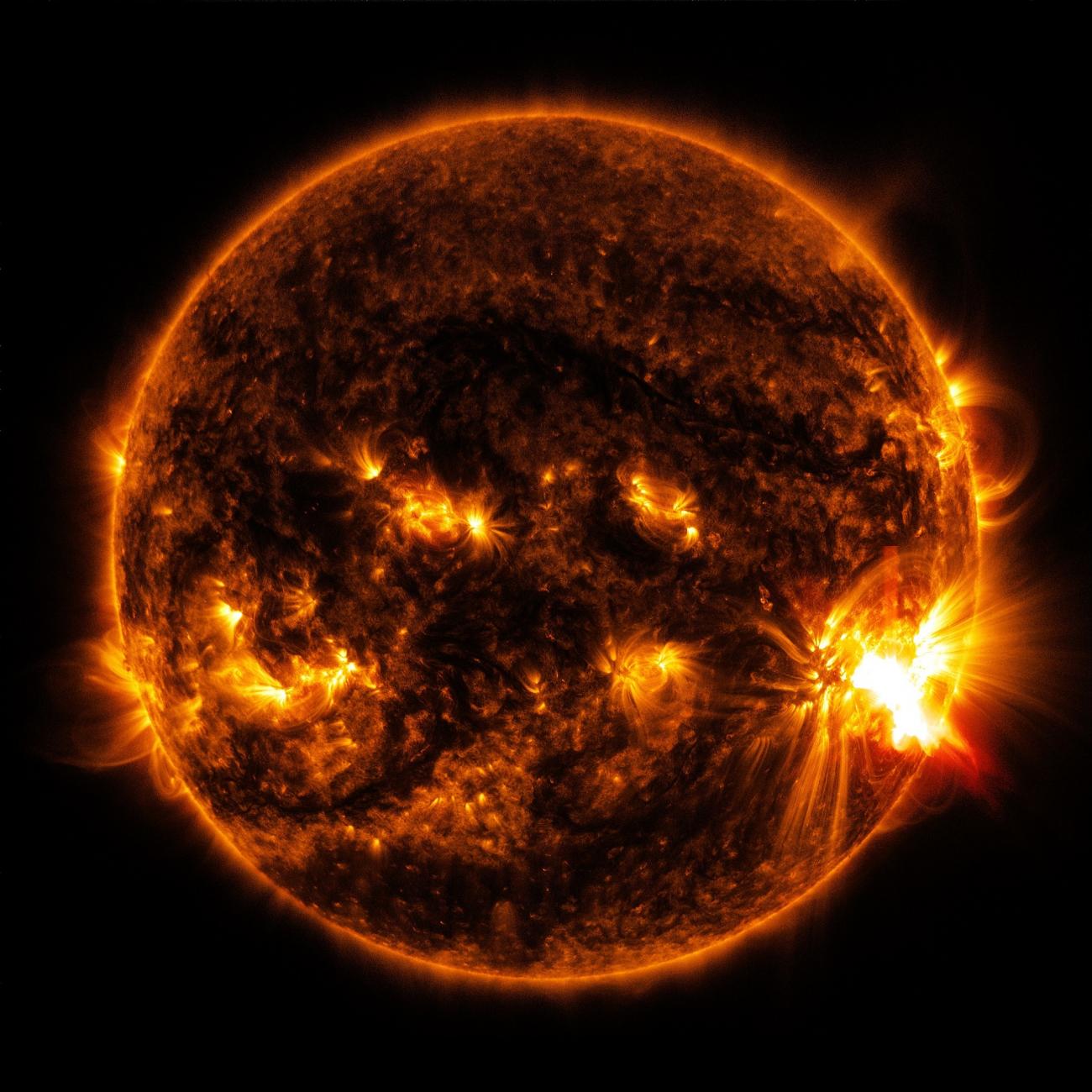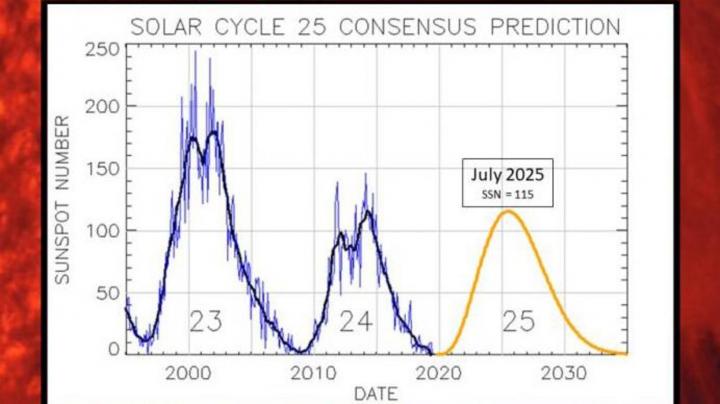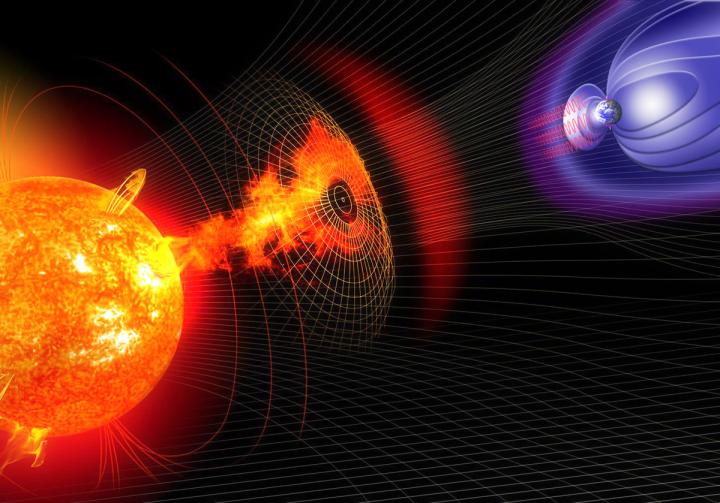A More Active Sun: Solar Cycle 25 Off to a Fast Start!

The Sun is growing more active! It appears the new solar cycle 25 is off to a fast start—already surpassing forecasts. So, what does this mean? Read more about our active sun.
Advertisement
The Old Farmer’s Almanac pays attention to solar science as it’s one of the disciplines employed in the making of our long-range weather predictions. See how The Old Farmer’s Almanac predicts the weather.
Our founder, Robert B. Thomas, who started this almanac back in 1792, believed that weather on Earth was influenced by the cooling and warming of the Sun, as evidenced by sunspot counts. Sunspots are fiery storms on the surface of the Sun. Learn more about sunspots.
We’re Now in Solar Cycle 25
We’ve now entered Solar Cycle 25 which is the 25th cycle of the Sun since record-keeping began in 1755.
Over the years of observing the Sun, we’ve learned that the Sun goes through warming and cooling cycles of about 11 years—which affects weather here on Earth.
When one 11-year solar cycle transitions to another, it starts quietly with low solar activity (called “solar minimum”). Then the Sun’s activity builds up to the cycle’s peak (called “solar maximum) when its magnetic field reverses. Finally, the Sun settles back down to a minimum before another cycle begins.
Learn more about solar cycles.
According to NOAA/NASA, Solar Cycle 25 began in December of 2019 and is expected to peak in mid-2025.
For reference, the prior Solar Cycle (24) lasted from December 2008 to December 2019 (an 11-year cycle). It was a very weak cycle in terms of solar activity—the weakest in the last 100 years. It “solar maximum” or peak occurred in April 2014 (with only 114 observed sunspots versus an average of 179).

Solar Cycle 25 Predictions
NOAA’s official forecast is for a weak solar cycle 25—below average, quiet, and cool. This is very similar to its predecessor Solar Cycle 24.
- According to NOAA/NASA and international experts: “Cycle 25 will be similar in size to Cycle 24, preceded by a long, deep minimum. Solar Cycle 25 may have a slow start, but is anticipated to peak with solar maximum occurring between 2023 and 2026, and a sunspot range of 95 to 130. This is well below the average number of sunspots, which typically range from 140 to 220 sunspots per solar cycle.”
- Specifically, the experts predicted a peak in July, 2025 (+/- 8 months), with a smoothed sunspot number (SSN) of 115. The panel agreed that Cycle 25 will be average in intensity and similar to Cycle 24, and its peak will be similar as well. Additionally, the panel concurred that solar minimum between Cycles 24 and 25 will occur in April 2020 (+/- 6 months).
Dissenting Opinions
Since the NOAA/NASA forecast, there have been further studies with models that suggest that Solar Cycle 25 could be one of the strongest since record-keeping began.
Other solar scientists have theorized that Solar Cycle 24 didn’t really end in December 2019 when Solar Cycle 25 began; rather, Cycle 24 “hung on” for two additional years while overlapping with Solar Cycle 25 and finally terminated in December 2021. This led to an “above average” forecast for Solar Cycle 25, sharply departing from NOAA’s official forecast of a weak solar cycle.
It will be interesting to follow these dissenting solar science forecasts as Cycle 25 unfolds. Remember, the number of sunspots weighs into the way that The Old Farmer’s Almanac predicts long-range weather.
Solar 25 Update (January 2022)
The Sun is in the rising part of its 11-year cycle of activity.
NOAA recently confirmed that Cycle 25 is outperforming the official forecast. As of January 2022, actual sunspot counts to date are stronger than predicted.

Credit: NOAA. See larger, interactive chart.
As Spaceweather.com reports, “Sunspot counts have exceeded predictions for 15 straight months. The monthly value at the end of December 2021 was more than twice the forecast, and the highest in more than 5 years.”
While Solar Cycle 25 is off to a strong start, this doesn’t necessarily mean that it will remain this active. The former Solar Cycle 24 also started strong but then weakened over time.
Time will tell. For now, we know the Sun will be heating up as it takes its journey towards its solar maximum.
Stay tuned!

Solar Cycle 24 Recap
If interested in reading further, below is the brief history of the last Solar Cycle (24), which we were watching since it began in December of 2008—two years later than expected. Solar Cycle 24 was one of the quietest, weakest cycles in a century. (The prior cycle, 23, also had an extended period of very few sunspots.)
Spotless Days (through September 16, 2020)
2020 total: 181 days (70%)
2019 total: 281 days (77%)
2018 total: 221 days (61%)
2017 total: 104 days (28%)
2016 total: 32 days (9%)
2015 total: 0 days (0%)
2014 total: 1 day (<1%)
2013 total: 0 days (0%)
2012 total: 0 days (0%)
2011 total: 2 days (<1%)
2010 total: 51 days (14%)
2009 total: 260 days (71%)
2008 total: 268 days (73%)
2007 total: 152 days (42%)
2006 total: 70 days (19%)
Brief History and Highlights of Cycle 24
–2008: Cycle 24 began (specifically on January 4).
–2011: Sunspots started to build again. A monthly spike occurred in November 2011.
–2012: Smoothed sunspot number reached a first peak of 98.3 (March, 2012).
–April 2014: Smoothed sunspot number reached a second peak of 116.4 (April, 2014). This became the official maximum. It’s not unusual to have a double peak, but it’s rare that the second peak is larger than the first. Cycle 24’s peak still ranks as the weakest since Cycle 14, which peaked in 1906.
–2015 to 2017: Sunspots dropped steadily from 0% spotless days in 2015 to 28% spotless days in 2017.
–2018: 61% of the days were spotless with weeks at a time without a single spot on the Sun’s face.
–2019: Even more days were spotless (77%), hitting rock bottom in December.
–2020: Sunspot counts were at their lowest at the start of year but started to pick up slowly.

Solar Activity and Weather on Earth
So, what do solar cycles mean in terms of climate and weather? Overall, history has shown us that quiet-to-average solar cycles with deep solar minimums mean a cooling pattern. In other words, temperatures become colder than they would have been otherwise. Sunspots are similar to a bathtub of lukewarm water; if you trickle in cold or hot water, it may take a while to notice the difference.
If this cooling phase on Earth, however, is offset by any warming caused by increasing greenhouse gases, it also raises the question of whether an eventual warming cycle could lead to more rapid warming on Earth than expected.
Could a deep, long-lasting solar minimum lead to extreme cold such as a mini ice age? In the 17th century, the 70-year Maunder Minimum brought a very cold period to the Earth.
- According to solar radiation expert Judith Lean, PhD, of the Naval Research Laboratory, if we do have a “Maunder Minimum,” it would not be a return to the “Little Ice Age.”
- She points to a current global surface temperature that’s about 1.8 degrees Fahrenheit warmer than at the time of the Maunder Minimum and says that a return to a Maunder Minimum phenomenon would lead to a cooling by only one-tenth of a degree C or 0.18 degree F.
Also, Lisa Upton, Ph.D., solar physicist with Space Systems Research Corp., states that “the expectation that Cycle 25 will be comparable in size to Cycle 24 means that the steady decline in solar cycle amplitude, seen from cycles 21 to 24, has come to an end and that there is no indication that we are currently approaching a Maunder-type minimum in solar activity.”
In other words, the occurrence of a new mini ice age is doubtful. Much of this is the normal ebb and flow of the Sun/Earth relationship, which can be stormy. That said, if the Sun goes through a more prolonged solar minimum, then Earth could experience a cooler period.
Aurora photo taken by Andrei Andritcu on January 9, 2022 in Tromsø Norway.
Real Immediate Effects of Solar Activity
With Solar Cycle 25 ramping up, strong solar storms are more likely to erupt, boosting the potential for both possible disruptions with satellites, radio communication, and power systems.
This is a very real threat. In early February 2022, a geomagnetic (solar) storm destroyed 40 new SpaceX satellites in orbit.
With the thousands of small satellites now in orbit which provide all of us with internet service and other communications, solar activity needs to be taken seriously.
On the bright side, more solar activity lends itself to more awesome displays of the bright auroras! Indeed, in early 2022, aurora watchers have been delighted to see some beautiful displays of geothermal activity.
